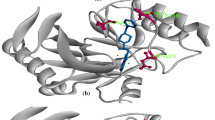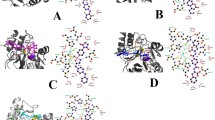Abstract
Antimicrobial resistance has emerged as a serious issue for physicians and health-care workers treating infections that could lead to the next pandemic. One of the key resistance mechanisms is beta-lactamases. Although several beta-lactamase inhibitors in combination with antibiotics have been created and are being utilized in clinical settings, resistance to these formulations has also been evolving in the bacterial population due to their distinct targets. In this study we used effective combination of antibiotic as an approach to inhibit multidrug resistance bacteria. We used four combinations and checked its efficacy against NDM (New Delhi Metallo-beta-lactamase) variants and functional gain laboratory mutant by employing FICI, enzyme kinetics, fluorescence and computational biology approaches (Docking and Molecular Dynamics Simulation). FICI values of all the combinations were either less than 0.5 or equal to 0.5. Binding features acquired by spectroscopic techniques showed important interaction and complex formation between drugs and enzymes with decreased ksv and kq values. In steady-state kinetics, a reduction in hydrolytic efficiency of enzymes was shown by cooperative binding behaviour when they were treated with different drugs. We have also tested functional gain laboratory mutant developed in our lab, keeping in view that if in future upcoming variants of this kind be emerged then these mutants could also be subsided by combinational therapy. This study identifies three other combinations better than fluoroquinolones effective against NDM variants and laboratory mutant.





Similar content being viewed by others
References
Martinez JL (2014) General principles of antibiotic resistance in bacteria. Drug Discov Today Technol 11:33–39. https://doi.org/10.1016/j.ddtec.2014.02.001
Miller WR, Munita JM, Arias CA (2014) Mechanisms of antibiotic resistance in enterococci. Expert Rev Anti Infect Ther 12:1221–1236. https://doi.org/10.1586/14787210.2014.956092
Roca I, Akova M, Baquero F et al (2015) The global threat of antimicrobial resistance: science for intervention. New Microbes New Infect 6:22–29. https://doi.org/10.1016/j.nmni.2015.02.007
Bodi M, Ardanuy C, Rello J (2001) Impact of Gram-positive resistance on outcome of nosocomial pneumonia. Crit Care Med 29:N82–N86. https://doi.org/10.1097/00003246-200104001-00005
Safdar N, Handelsman J, Maki DG (2004) Does combination antimicrobial therapy reduce mortality in Gram-negative bacteraemia? A meta-analysis. Lancet Infect Dis 4:519–527. https://doi.org/10.1016/S1473-3099(04)01108-9
Mouton JW (1999) Combination therapy as a tool to prevent emergence of bacterial resistance. Infection 27:S24–S28. https://doi.org/10.1007/BF02561666
From the American Association of Neurological Surgeons (AANS), American Society of Neuroradiology (ASNR), Cardiovascular and Interventional Radiology Society of Europe (CIRSE), Canadian Interventional Radiology Association (CIRA), Congress of Neurological and WSO (WSO), Sacks D, Baxter B et al (2018) Multisociety consensus quality improvement revised consensus statement for endovascular therapy of acute ischemic stroke. Int J Stroke 13:612–632. https://doi.org/10.1177/1747493018778713
Paul M, Lador A, Grozinsky-Glasberg S, Leibovici L (2014) Beta lactam antibiotic monotherapy versus beta lactam-aminoglycoside antibiotic combination therapy for sepsis. Cochrane Database Syst Rev. https://doi.org/10.1002/14651858.CD003344.pub3
Tamma PD, Cosgrove SE, Maragakis LL (2012) Combination therapy for treatment of infections with gram-negative bacteria. Clin Microbiol Rev 25:450–470. https://doi.org/10.1128/CMR.05041-11
Paul M, Carmeli Y, Durante-Mangoni E et al (2014) Combination therapy for carbapenem-resistant Gram-negative bacteria. J Antimicrob Chemother 69:2305–2309. https://doi.org/10.1093/jac/dku168
Ali A, Gupta D, Srivastava G et al (2019) Molecular and computational approaches to understand resistance of New Delhi metallo β-lactamase variants (NDM-1, NDM-4, NDM-5, NDM-6, NDM-7)-producing strains against carbapenems. J Biomol Struct Dyn 37:2061–2071. https://doi.org/10.1080/07391102.2018.1475261
Ali A, Azam MW, Khan AU (2018) Non-active site mutation (Q123A) in New Delhi metallo-β-lactamase (NDM-1) enhanced its enzyme activity. Int J Biol Macromol 112:1272–1277. https://doi.org/10.1016/j.ijbiomac.2018.02.091
Farhat N, Gupta D, Ali A et al (2022) Broad-spectrum inhibitors against class A, B, and C Type β-lactamases to block the hydrolysis against antibiotics: kinetics and structural characterization. Microbiol Spectr. https://doi.org/10.1128/spectrum.00450-22
Farhat N, Ali A, Waheed M et al (2022) Chemically synthesised flavone and coumarin based isoxazole derivatives as broad spectrum inhibitors of serine β-lactamases and metallo-β-lactamases: a computational, biophysical and biochemical study. J Biomol Struct Dyn. https://doi.org/10.1080/07391102.2022.2099977
Galleni M, Franceschini N, Quinting B et al (1994) Use of the chromosomal class A beta-lactamase of Mycobacterium fortuitum D316 to study potentially poor substrates and inhibitory beta-lactam compounds. Antimicrob Agents Chemother 38:1608–1614. https://doi.org/10.1128/AAC.38.7.1608
Farhat N, Khan AU (2021) Repurposing drug molecule against SARS-Cov-2 (COVID-19) through molecular docking and dynamics: a quick approach to pick FDA-approved drugs. J Mol Model 27:1–11. https://doi.org/10.1007/s00894-021-04923-w
Kim S, Chen J, Cheng T et al (2019) PubChem 2019 update: improved access to chemical data. Nucleic Acids Res 47:D1102–D1109. https://doi.org/10.1093/nar/gky1033
Biasini M, Bienert S, Waterhouse A et al (2014) SWISS-MODEL: modelling protein tertiary and quaternary structure using evolutionary information. Nucleic Acids Res 42:W252–W258. https://doi.org/10.1093/nar/gku340
Benkert P, Künzli M, Schwede T (2009) QMEAN server for protein model quality estimation. Nucleic Acids Res 37:W510–W514. https://doi.org/10.1093/nar/gkp322
Laskowski RA, MacArthur MW, Moss DS, Thornton JM (1993) PROCHECK: a program to check the stereochemical quality of protein structures. J Appl Crystallogr 26:283–291. https://doi.org/10.1107/S0021889892009944
Wiederstein M, Sippl MJ (2007) ProSA-web: interactive web service for the recognition of errors in three-dimensional structures of proteins. Nucleic Acids Res 35:W407–W410. https://doi.org/10.1093/nar/gkm290
Sievers F, Wilm A, Dineen D et al (2011) Fast, scalable generation of high-quality protein multiple sequence alignments using Clustal Omega. Mol Syst Biol. https://doi.org/10.1038/msb.2011.75
Jones G, Willett P, Glen RC (1995) Molecular recognition of receptor sites using a genetic algorithm with a description of desolvation. J Mol Biol 245:43–53. https://doi.org/10.1016/S0022-2836(95)80037-9
Beg AZ, Farhat N, Khan AU (2021) Designing multi-epitope vaccine candidates against functional amyloids in Pseudomonas aeruginosa through immunoinformatic and structural bioinformatics approach. Infect Genet Evol 93:104982. https://doi.org/10.1016/j.meegid.2021.104982
Schüttelkopf AW, van Aalten DMF (2004) PRODRG : a tool for high-throughput crystallography of protein–ligand complexes. Acta Crystallogr Sect D Biol Crystallogr 60:1355–1363. https://doi.org/10.1107/S0907444904011679
Sharma M, Farhat N, Khan AU et al (2023) Studies on the interaction of 2,4-dibromophenol with human hemoglobin using multi-spectroscopic, molecular docking and molecular dynamics techniques. J Biomol Struct Dyn. https://doi.org/10.1080/07391102.2023.2264975
Chen Z, Xu H, Zhu Y et al (2014) Understanding the fate of an anesthetic, nalorphine upon interaction with human serum albumin: a photophysical and mass-spectroscopy approach. RSC Adv 4:25410–25419. https://doi.org/10.1039/C4RA03541K
Palm GJ, Lederer T, Orth P et al (2008) Specific binding of divalent metal ions to tetracycline and to the Tet repressor/tetracycline complex. JBIC J Biol Inorg Chem 13:1097–1110. https://doi.org/10.1007/s00775-008-0395-2
Hancock RE, Farmer SW, Li ZS, Poole K (1991) Interaction of aminoglycosides with the outer membranes and purified lipopolysaccharide and OmpF porin of Escherichia coli. Antimicrob Agents Chemother 35:1309–1314. https://doi.org/10.1128/AAC.35.7.1309
Dalhoff A (2021) Selective toxicity of antibacterial agents—still a valid concept or do we miss chances and ignore risks? Infection 49:29–56. https://doi.org/10.1007/s15010-020-01536-y
Michalak K, Sobolewska-Włodarczyk A, Włodarczyk M et al (2017) Treatment of the fluoroquinolone-associated disability: the pathobiochemical implications. Oxid Med Cell Longev 2017:1–15. https://doi.org/10.1155/2017/8023935
Acknowledgements
We acknowledge the facility and support provided by the Department of Biotechnology, Ministry of science and technology, Government of India.
Funding
We acknowledge funding from the DBT, Government of India, Grant No. BT/PR40148/BTIS/137/20/2021, Tata Innovation Fellowship, BT/HRD/TIF/09/04/2021-22 and NNP DBT GRANT: BT/PR40180/BTIS/137/59/2023. NF is also recipient of senior research fellow from mentioned project.
Author information
Authors and Affiliations
Contributions
NF, performed all experiments and wrote manuscript, SM, performed some of the experiments, AUK, conceived problem and guided the study provided resources and checked first draft of manuscript.
Corresponding author
Ethics declarations
Conflict of interest
The authors report no conflicts of interest.
Ethical approval
Not applicable.
Informed consent
No consent is required.
Additional information
Publisher's Note
Springer Nature remains neutral with regard to jurisdictional claims in published maps and institutional affiliations.
Supplementary Information
Below is the link to the electronic supplementary material.
Rights and permissions
Springer Nature or its licensor (e.g. a society or other partner) holds exclusive rights to this article under a publishing agreement with the author(s) or other rightsholder(s); author self-archiving of the accepted manuscript version of this article is solely governed by the terms of such publishing agreement and applicable law.
About this article
Cite this article
Farhat, N., Mujahid, S. & Khan, A.U. Mechanistic Approach of Effective Combination of Antibiotics Against Clinical Bacterial Strains Having New Delhi Metallo-Beta-Lactamase Variants and Functional Gain Laboratory Mutant. Curr Microbiol 81, 41 (2024). https://doi.org/10.1007/s00284-023-03553-0
Received:
Accepted:
Published:
DOI: https://doi.org/10.1007/s00284-023-03553-0




